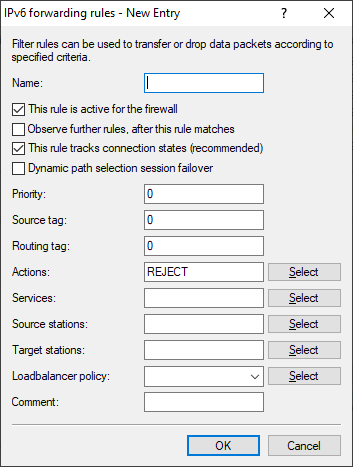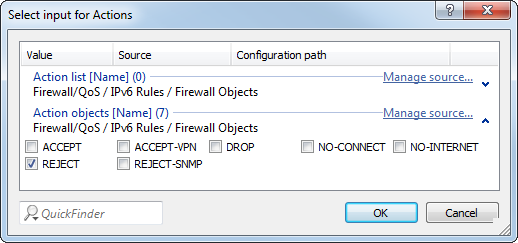The IPv6 forwarding rules button accesses dialog where you set the rules that the IPv6 firewall should use to handle forwarded traffic.
The factory settings provide various rules for the most important applications.
In order to change the order of the rules, highlight the specific rule in the table and move it up or down in the table by clicking on the arrow buttons. The firewall applies the rules one after the other from top to bottom.
Click on Add to create a new rule.

You can set the following properties for the rule:
- Name
- Specifies the name of the rule.
- This rule is active for the firewall
- Enables the rule.
- Observe further rules after this one matches
- If you enable this option, the firewall also applies the subsequent rules in the list. This is useful if the firewall should, for example, initially apply a group rule and then apply each rule to the individual objects in the group.
- This rule tracks connection states (recommended)
- Select this option if the rule should track the TCP connection states.
- Dynamic Path Selection Session Failover
- Specifies whether the sessions under these rules should be moved to a better line as identified by Dynamic Path Selection. This is only possible for unmasked connections, e.g. VPN connections. See also Switchover-Profiles.
- Priority
- Specifies the priority of the rule: The higher the value, the higher the priority.
- Src-Tag
- Enter an interface or routing tag here (tag context) if you want the rule to apply only to packets marked in this way. The default value of 0 means that this rule applies to all packets regardless of the interface or routing tag. Note: If only packets with the interface or routing tag 0 are to be considered, then 65535 must be specified here.
- Routing tag
- The interface tag that you enter here is a value that uniquely identifies the network. All packets received by this device on this network will be internally marked with this tag. The interface tag makes it possible to separate the rules valid for this network.
- Actions
- Specifies the action that the firewall performs if the rule condition is true. Using Select you can choose one action or a list of actions.
If you make a new entry here, it initially appears under Unknown source. Next, highlight the entry for a source that you want to assign to the new entry, and click on Manage source. Set the values for this entry, and save the new object. The new entry now appears as a new object in the list of the corresponding source.

- Services
- Determines the services which the firewall applies this rule to. Using Select you can choose one service or a list of services.
- Source stations
- Determines the source stations which the firewall applies this rule to. Using Select you can choose one station or a list of stations.
- Target stations
- Determines the target stations which the firewall applies this rule to. Using Select you can choose one station or a list of stations.
- Comment
- Here you assign a meaningful description for the filter rule.
